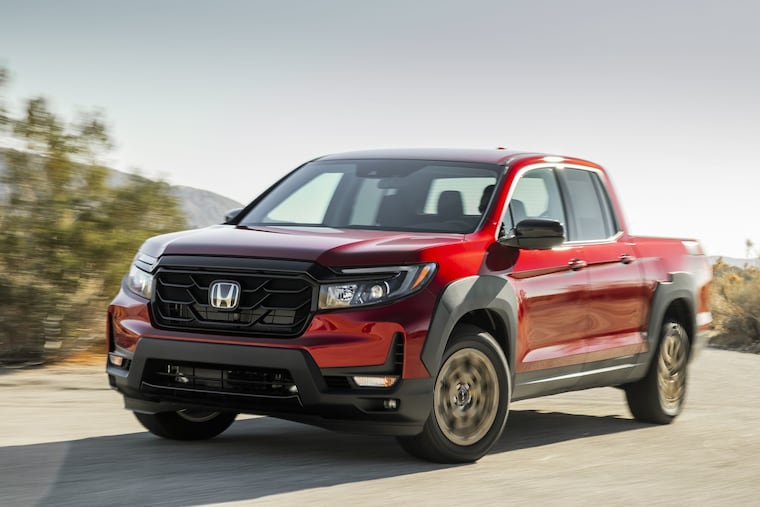2022 Honda Ridgeline vs. 2022 Hyundai Santa Cruz: Changes among small haulers
The mid-size pickup market is getting new focus. Honda has redesigned its popular Ridgeline model to keep ahead of the competition.

2022 Honda Ridgeline AWD Sport vs. 2022 Hyundai Santa Cruz Limited AWD: Small package haul-off.
This week: 2022 Honda Ridgeline
Price: $40,860 as tested. The HPD Package added fender flares, decals, and big, golden wheels for $2,800. Money well-spent.
Conventional wisdom: Car and Driver likes that the “interior feels huge for the class, quick and refined on the road, several innovative features,” but not that “competitors tow more, rivals offer legit off-road models, subpar braking performance.”
Marketer’s pitch: “Amp up your ride.”
Reality: Nice, but becoming out-amped by some competitors.
» READ MORE: 2017 Honda Ridgeline: 'The holy grail' of midsized trucks
Is small what’s big? After the midsize pickup selection withered as much as the minivan segment about five years ago, the genre is back and growing, especially at the small end. But Honda has been there all along. And joining the Ridgeline in the front-wheel-drive-based pickup market is next week’s contestant, the Hyundai Santa Cruz, and the Ford Maverick (which has not yet been secured for a Mr. Driver’s Seat ride).
Among larger, rear-wheel-drive-based models are the Toyota Tacoma, Ford Ranger, Chevy Colorado/GMC Canyon, Jeep Gladiator, and Nissan Frontier.
What’s new: The Ridgeline received an exterior redesign for 2021, and now it looks more like a truck than an Acura TLX with a Dumpster screwed onto the back end. On the performance side of that redesign, front-wheel drive has been discontinued and torque vectoring all-wheel drive is standard in all models, enhancing control and traction over that old all-wheel-drive stuff that we laughably thought was good enough.
Up to speed: The 3.5-liter V-6 creates 280 horsepower, more than enough to get the Ridgeline going in a hurry. It gets to 60 in 7.2 seconds, according to Edmunds.
Shifty: The Ridgeline gets Honda’s 9-speed automatic transmission. Shifting is available using paddles, and that all works very well.
I didn’t even think to complain about the push-button transmission standard in Hondas until I was finishing up the review, so I must have fully accommodated this change after far too many years. Finally.
The truck also comes with a Sport mode that works well enough, but it held on to lower gears for a long time, and I could never seem to get it to move beyond seventh gear even on highways unless I shifted myself. Not a problem for me, but something buyers may want to know about, and you’ll probably end up paying for it at the pump.
» READ MORE: 2020 Ford Ranger offers big things in a small package
On the road: Sport mode turns the Ridgeline into a nice-handling truck, with plenty of zip on the curves and in tight places. Still, I felt like the Ford Ranger SXT or GMC Canyon AT4 made nicer companions on the winding roads.
Driver’s Seat: The Ridgeline as tested came with very basic cloth seats, Sport trim being the lowest of four.
The seats provided great comfort, and would be super swell if they came with power adjustments, but alas, it was all cranks and levers for the week of testing.
The dashboard provides clear information without a lot of surprises, always a good thing.
Friends and stuff: The rear seat provides a comfortable space in theory — there’s plenty of legroom, headroom, and foot room.
But, in reality, the seat feels thin and as stiff as a board, and the seat back sits far too straight to offer any comfort. There is a console armrest, though, so it’s not like the 1980s or anything, but buyers with passengers in a recurring role may want to consider the dead-cow version. Or some comfy pillows.
The seat bottom does fold up from the floor to create a nice auxiliary storage area, and it divides 60/40 for passenger accommodations, as well.
The bed provides just over 1,500 pounds of payload capacity and is 64 inches long, so it wins for versatility if not for overall weight-bearing abilities. Towing capacity matches the Santa Cruz’s maximum at 5,000 pounds.
The locking trunk under the bed remains a nice feature.
» READ MORE: 2021 GMC Canyon AT4: Challenging the Ranger and Gladiator
Play some tunes: The bare-bones 215-watt, seven-speaker Honda stereo was the anti-Odyssey sound system. Where that minivan uncovered parts of songs I’d never before noticed, the Ridgeline covered them right back up — and tossed in pieces I’d heard again and again — patted them all down tight and drove over them three or four times for good measure.
It’s as if Toyota and a 1970s Philco AM radio had a stereo baby.
But at least operating the system was smooth. I could switch from function to function seamlessly. And now there’s a volume knob, touted as the lead item among redesign features in Honda press materials. Obviously, it’s important, and you just thought I was a whiner (every week, volume and tuning knobs, volume and tuning knobs, wahwahwah).
Keeping warm and cool: The Ridgeline offers the standard Honda HVAC interface, as well, with toggles for temperature and buttons for everything else. It works simply, though knobs are simpler.
Fuel economy: I averaged a disappointing 18 mpg in a wide round of testing the Ridgeline, far lower than my previous 21.5 in a 2017 model.
Where it’s built: Lincoln, Ala.
How it’s built: Consumer Reports blesses the Ridgeline with a reliability of 4 out of 5, matching 2021, down a tick from 2020 but better than earlier years.
Next week: 2022 Hyundai Santa Cruz AWD Limited